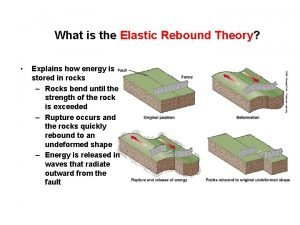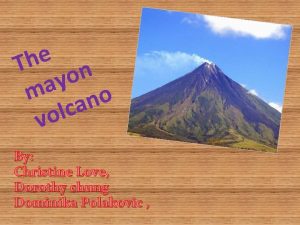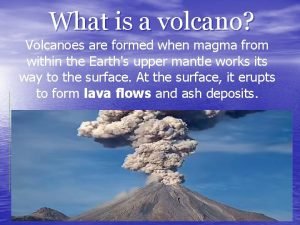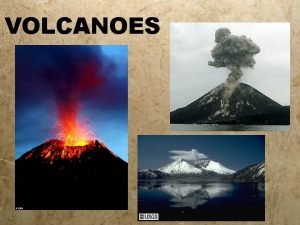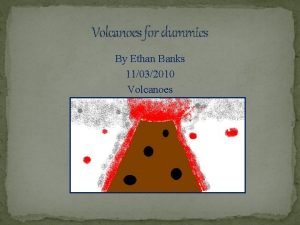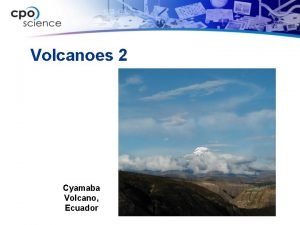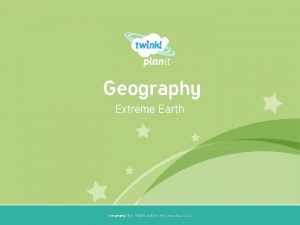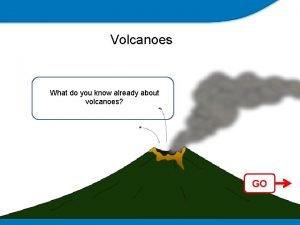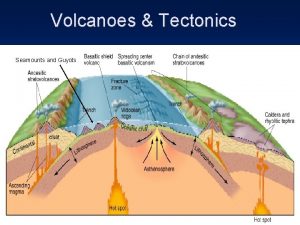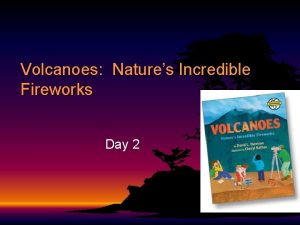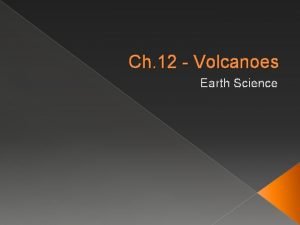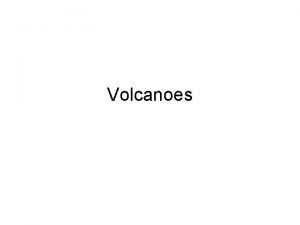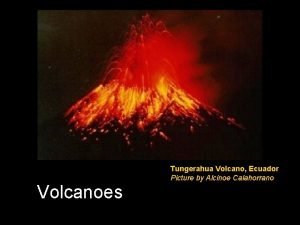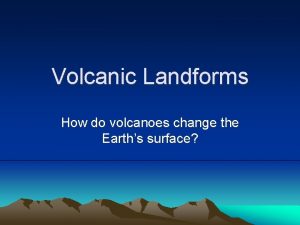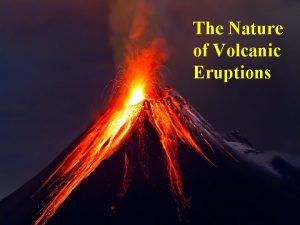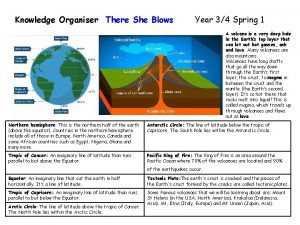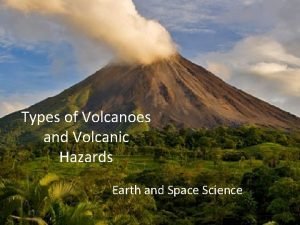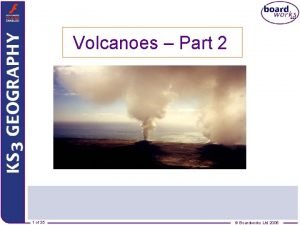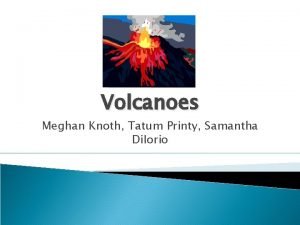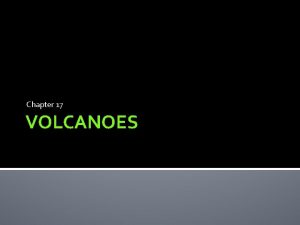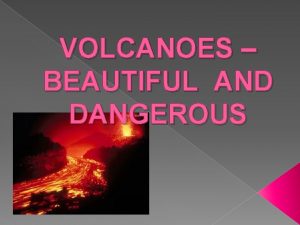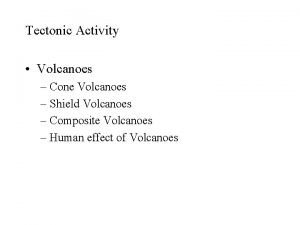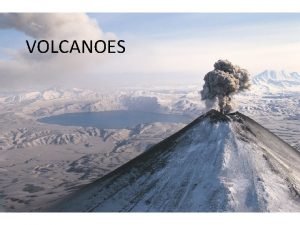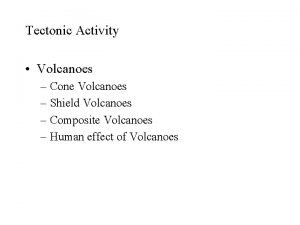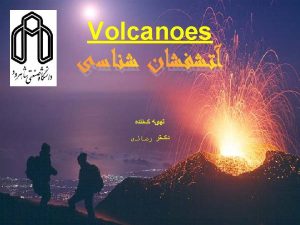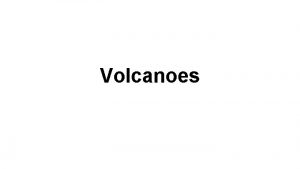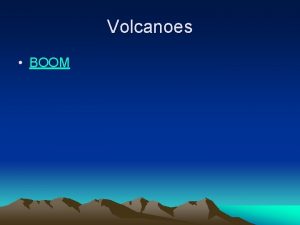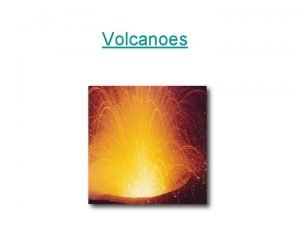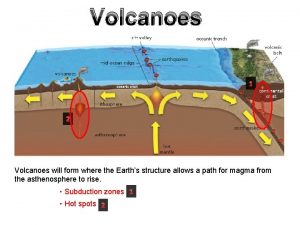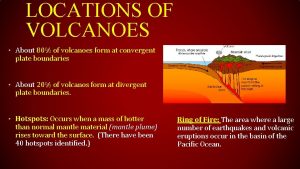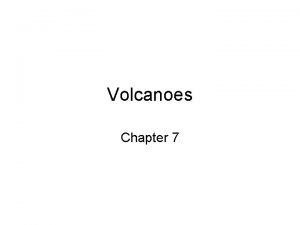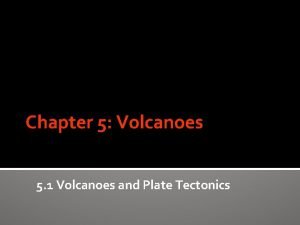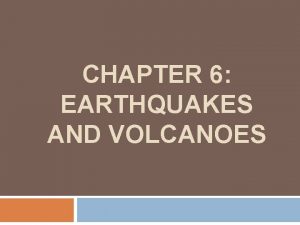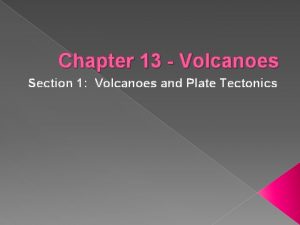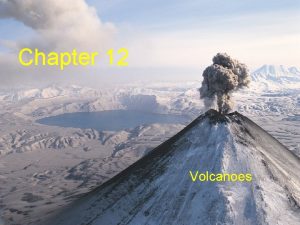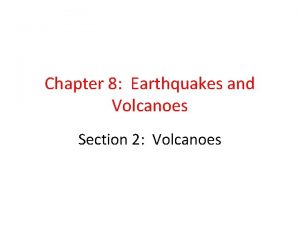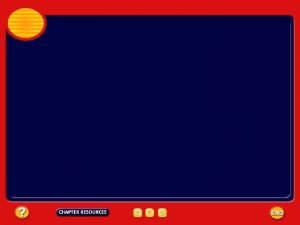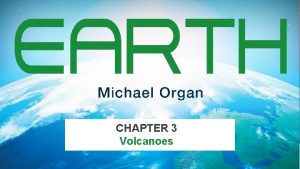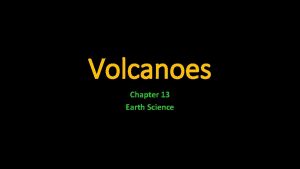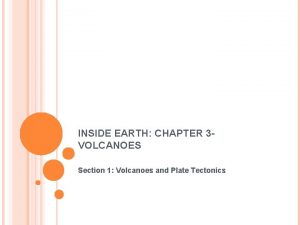CHAPTER 9 VOLCANOES HOW AND WHERE VOLCANOES FORM























- Slides: 23

CHAPTER 9 VOLCANOES

HOW AND WHERE VOLCANOES FORM What is a volcano? It refers to an opening that releases molten rock, gases and ash. It also includes the landform that forms around that opening.

HOW AND WHERE VOLCANOES FORM Magma Formation Three conditions are needed for magma formation A decrease in pressure can cause the melting point to drop allowing melting of rock. Increase in temp (DUH!). These are called hot spots. Increase of water in the asthenosphere can lower the melt point (subduction zones).

HOW AND WHERE VOLCANOES FORM Subduction Boundaries We remember that the products of subduction boundaries are? Trenches Volcanoes – form on the overriding plate due to the diving ocean plate carrying water and lowering the melting points. (Volcanic island arcs in the ocean and volcanoes on continental plates)

HOW AND WHERE VOLCANOES FORM What is a divergent boundary? A boundary b/t two lithosphere plates that are moving apart. Most exist on the ocean floor and have rift valleys (deep valleys at the center of mid ocean ridges) Rifts - Where molten rock forces its way b/t cracks on ocean floors causing spreading (sea floor spreading)

HOW AND WHERE VOLCANOES FORM Hot Spots These areas where solid hot material melts the material in lower pressure areas. These are not plate boundaries. As plates move, hot spots remain stationary. Ex. Hawaiian Islands

MAGMA AND ERUPTED MATERIAL Types of Magma (The viscosity of magma is dependent on the amount of silica present in the magma. High Si. O = high viscosity and vice versa) Magma also contains gases like water vapor and carbon dioxide. Basaltic Magma – Low Si. O content which gives it an ease of flow. Andesitic and Rhyolitic magma has high Si. O content, therefore it doesn’t flow easily (high viscosity).

MAGMA AND ERUPTED MATERIAL Basaltic magma Low silica content Flows easily (low viscosity) Gas escapes easily causing relatively harmless fountains and floods. Generally forms at rifts and oceanic hotspots.

MAGMA AND ERUPTED MATERIAL Andesitic and Rhyolitic Magmas High Si. O content Slower flow (high viscosity) Gases don’t escape as easily causing explosions (Mt. St. Helens) Andesitic magmas tend to form at subduction boundaries. Rhyolitic magmas tend to form at continental hotspots.

MAGMA AND ERUPTED MATERIAL Lava Flows on land (Lava magma that reaches the Earth’s surface). There are two types of land lava flow (both basaltic flows): Pahoehoe – High temp/low viscosity/ropelike surfaces. Aa – Cooler lava that cools quickly/ rough jagged surfaces.

MAGMA AND ERUPTED MATERIAL Underwater Lava Flows: Pillow Lava – Has a rounded shape w/a crust. When pressure increases the crust cracks and more lava pours out.

MAGMA AND ERUPTED MATERIAL Ash and Rock Fragment Pyroclastics Material – When magmas contain trapped gas, the resulting action is explosive eruptions. These eruptions throw solid fragments called pyroclastics. Ash – Smallest pieces are called ashes (<2 mm). Lapilli – The intermediate material (2 -64 mm) Blocks and Bombs – the largest pieces (>64 mm)


MAGMA AND ERUPTED MATERIAL Pyroclastic Flow – A combination of pyroclastic material with superheated gases that flow down hill at a high rate of speed. Mt. Vesuvius buried Pompeii with pyroclastic flow.


VOLCANIC LANDFORMS Shield Volcano – Basaltic lava tends to flow over great distance before hardening. This allows for wide gently sloping bases that can support enormous heights. They are less explosive, but the lava flows are dangerous and can be expensive. Mauna Loa – Starts 5000 m above below sea level and rises 4170 above sea level (9170 m total height)

VOLCANIC LANDFORMS Cinder Cone Typically smaller Formed from molten lava being thrown into the air, breaking into fragments and hardening before they hit ground. They accumulate forming a cone w/an oval bottom. Typically form in groups and on sides of larger volcanoes.

VOLCANIC LANDFORMS Composite Volcano Forms when layers are deposited from successive explosive eruptions around the vent. Ex. Mt. St. Helen erupted in 1980. The hot ash mixed w/snow and ice to create a fast moving mudslide called lahar.


VOLCANIC LANDFORMS Calderas – After a volcano partially empties a magma chamber the top of the cone collapses. This forms a crater (calderas).

EXTRATERRESTRIAL VULCANISM Volcanoes occur in more places than Earth. Venus – Has over 1600 volcanoes although most are inactive.

EXTRATERRESTRIAL VULCANISM Volcanoes occur in more places than Earth. Io (one of the Galilean moons of Jupiter) One of the most vocanically active places in the solar system.

EXTRATERRESTRIA L VOLCANISM Volcanoes occur in more places than Earth. Mars – Olympus Mons is located on Mars. It is the tallest known volcano in our solar system.
 Chapter 8 earthquakes and volcanoes
Chapter 8 earthquakes and volcanoes Explain the elastic rebound theory
Explain the elastic rebound theory Differentiate active and inactive volcanoes
Differentiate active and inactive volcanoes What are destructive forces
What are destructive forces How are volcanoes formed
How are volcanoes formed How are volcanoes classified
How are volcanoes classified Volcanoes for dummies
Volcanoes for dummies Cotapoxi
Cotapoxi Extreme earth
Extreme earth What do you already know about volcanoes
What do you already know about volcanoes Three main ways volcanoes are created
Three main ways volcanoes are created Volcanoes nature's incredible fireworks
Volcanoes nature's incredible fireworks Types of volcanoes
Types of volcanoes How are volcanoes formed
How are volcanoes formed Most volcanoes occur __________. *
Most volcanoes occur __________. * Active volcanoes map
Active volcanoes map Krakatoa volcano
Krakatoa volcano Big island size broad slightly domed
Big island size broad slightly domed Volcanoes knowledge organiser
Volcanoes knowledge organiser Types of volcanoes
Types of volcanoes Ring of fire volcanoes
Ring of fire volcanoes Magma chamber
Magma chamber Shield volcanoes
Shield volcanoes Types of volcanoes
Types of volcanoes

